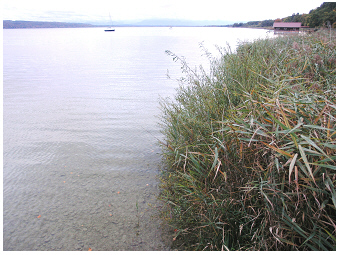Über den Ammersee: ein See im zeitlichen gleichtakt mit anderen Seen
die geographische lage des sees in den bayerischen alpen
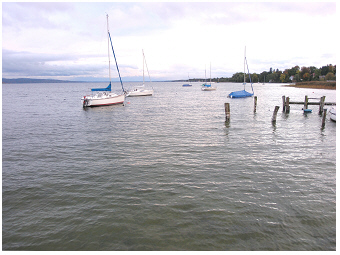 Ammeree, 2012:
Ammeree, 2012:
Blick vom Westufer, von Schondorf aus, in die südliche Richtung des
Seebeckens.
Der Ammersee (48°00’34.5''N,
11°7’2.4''E)
ist ein voralpiner See. Er liegt
524 m über dem Meeresspiegel in Oberbayern (Deutschland), etwa 50 km
entfernt von München.
Der See zählt zu den sechs größten Seen in
Deutschland, hat ein Wasservolumen von 1750 x 106 m3,
eine Fläche von
46.61 km2 und eine maximale Tiefe von
81 m. Die Verweildauer des
Wassers beträgt 2.7 Jahre (Tabelle 1
in Dokulil et
al.
2006 R).
Der Ammersee wird als mesotroph eingestuft. Dies bedeutet, dass die
Nährstoffkonzentrationen im See,
vor allem von dem Nährelement
Phosphor, leicht über dem natürlich niedrigen Nährstoffniveau der
voralpinen Seen liegen. Das Uferröhricht wird über weite Strecken von
Schilf (Phragmites australis)
gebildet. Solche breiten
Schilfgürtel sind
am Ammersee noch weit verbreitet ausgebildet, wodurch die natürliche
Wasserreinhaltung des Sees unterstützt wird. Hier unterscheidet sich
der Ammersee wesentlich vom
Mondsee S
im Salzkammergut. Neben urbanen
Bereichen ist
das bestimmende Bild der Ufer am Ammersee durch intakte Schilfbestände
gekennzeichnet. Am
Mondsee dagegen entsprechen sowohl die
Schilfbestände als auch die Uferbereiche in weiten Bereichen
nicht mehr
dem ursprünglich-natürlichen Zustand.
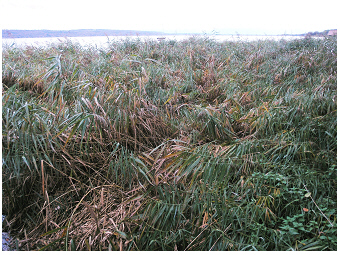 Ammersee, 2012:
Ammersee, 2012:
Das Schilf (Phragmites
australis) bildet breite Röhrichtgürtel am
Westufer.
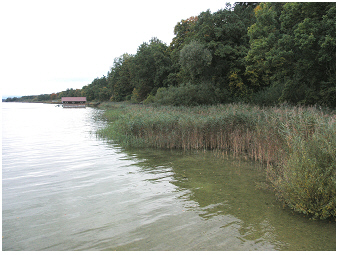 Ammersee, 2012:
Ammersee, 2012:
Blick auf den Röhrichtgürtel am Westufer. Im seichten Uferwasser
(litorale Zone des Sees) breitet sich das Schilf aus.
Wie die Seen im Salzkammergut in Österreich (siehe Website zum alpinen Attersee S), profitiert auch der Ammersee von seinem alpinen Einzugsgebiet. Dies wird im Wesentlichen durch eine nachhaltige Landwirtschaft und einen kontrollierten Umgang mit Abwässern über Kläranlagenbehandlung in den bayerischen Alpen gewährleistet.
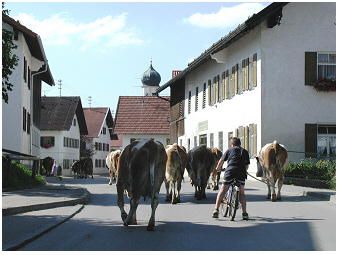 Einzugsgebiet vom
Ammersee, 2002:
Einzugsgebiet vom
Ammersee, 2002:
Nachhaltige Milchkuh-Viehhaltung in den Dörfern um den Ammersee. Das
Foto wurde in
Haunshofen aufgenommen (Landkreis Weilheim - Schongau).
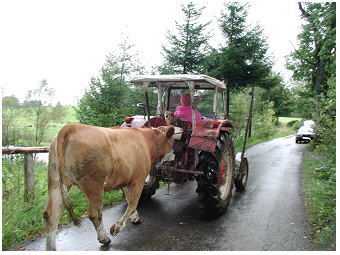 Einzugsgebiet vom Ammersee, 2002:
Einzugsgebiet vom Ammersee, 2002:
Traditionelle Tierhaltung in der Ebene während der Vegetationsperiode.
Im nachfolgenden Text wird die Erwärmung des Tiefenwassers durch
Klimaeffekte für
den Ammersee beschrieben. Der Gleichklang der
Klimaeffekte auf zugleich andere Seen in Europa wird dargestellt.
Darüber hinaus wird der Ammersee detaillierter mit dem Mondsee in dem
Abschnitt "Ammersee und Mondsee: Zwei ähnliche Seen" verglichen
(ammersee and mondsee: two lakes but one story). Einen breiteren Raum
nimmt dabei die Beschreibung des Phytoplanktons ein. Beide Seen sind
von dem metalimnetischen Cyanobakterium
Planktothrix
rubescens
geprägt
(sommerliches Vorkommen in der Tiefenwasserschicht 7-12 m).
Darüber
hinaus wird die Phytoplanktonzusammensetzung
für die verschiedenen
Oberflächen- und Tiefenwasserschichten im Ammersee im Detail
beschrieben. Eine Vielfalt von begeißelten
Phytoplanktonarten wird
entlang der Tiefenprofile im Ammersee gefunden. Mehr als 40% der 83
gefundenen Phytoplanktontaxa sind hier solche bewegliche Flagellaten.
deepwater warming and climate response of lake ammersee shows a particular close regional synchrony with lakes of the western alps
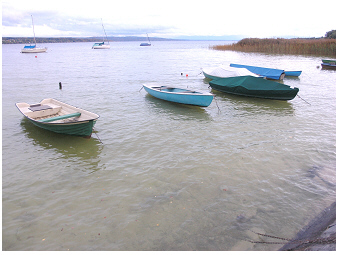 Ammersee, 2012:
Ammersee, 2012:
Blick vom nördlichen Westufer über den See in Richtung Süden.
The coherence,
i.e.
the synchrony, between lakes can be analysed by the
correlation between time-series of lake-data over a same certain time
period. As climate is global and may affect regional weather conditions
in many places, an unusual warm or cold winter-spring period will
certainly not only affect a single lake but many lakes over longer
distances across Europe at the same time. As mentioned for Mondsee,
coherence is best seen for the over-all lake physics as e.g. water
temperature than for lake-specific issues, as e.g. catchment dependent
chemistry, human impacted nutrient availability or biology.
A synchrony of deepwater temperature was indeed found between 12
studied lakes across Europe, from Sweden, United Kingdom, Germany,
Austria, Switzerland and France (Fig.2
in Dokulil et
al.
2006 R).
The deepwater
temperatures of the hypolimnion varied from year to year
but increased in
all these lakes by about
0.1–0.2°C per decade (Figs.2&4,
Table 4 in Dokulil et
al.
2006 R).
The most consistent predictor of
hypolimnetic temperatures was seen in the climate signal of the
North Atlantic
Oscillation (specifically the mean NAO index for
January–May), which explained 22-63 % of the interannual
variation of
lake temperatures in 10 of 12 the lakes (exceptions were two remote
lakes in less wind-exposed alpine valleys; lake Walensee and lake
Hallstätter See). Lake Ammersee shown in this study has the closest
deepwater synchrony to four lakes in the western Alps, i.e. to Lake
Geneva, Zürichsee, Walensee and lake Constance, than to lakes
elsewhere.
ammersee and mondsee: two lakes but one story
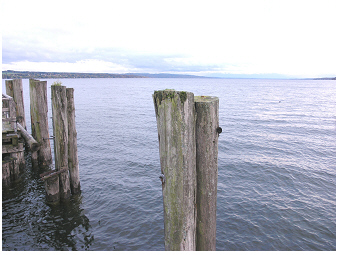 Ammersee, 2012:
Ammersee, 2012:
Blick vom nördlichen Teil des Westufers in Richtung Süden über den
See.Lake
Ammersee is about 200 km
away from lake , with a catchment area that is
about four times larger than of
Mondsee S. The lake basin
of Ammersee is
about 10m deeper and has a three times larger water volume and water
surface, respectively, than Mondsee. The water retention time is
accordingly more extended than for Mondsee, namely 1 year
longer (2.7 years). Both lakes are mesotrophic.
The section before described the synchrony of deep water warming trends
in various lakes across Europe. The temporal coherence of water surface
temperature trends between neighbouring lakes, however, can be even
stronger. Therefore, despite the rather weak coherence of deepwater
warming in Ammersee and Mondsee, an indeed significant strong synchrony in particular for water
surface temperature, but also for some parameters
describing the whole water body seasonality was found. Very similar to
Mondsee S
, the time lag between the annual peak of total incoming
radiation and air temperature is 32 days, the surface water
temperature
42 days, the thermal stability of water column calculated as
Schmidt
stability 45 days and the heat content of the whole water body of lake
Mondsee 54 days, respectively. As in Mondsee, the timing of the annual
maximum of these temperature related parameters and the spring peak of
phytoplankton tend to pass earlier the year (study period 1985-2001).
Phytoplankton composition in Ammersee is similar to that of Mondsee as both alpine lakes passed years of eutrophication before restoration, mainly achieved by sewage treatment in the catchment, which turned the lake to a reoligotrophication period. As in Mondsee, the cyanobacterium Planktothrix rubescens contributed mostly to phytoplankton biovolume and formed a pronounced deep chlorophyll maximum (DCM) at the layer from 7-12 m (Fig.2i in Teubner et al. 2003 R, Figs.11&28 in Teubner et al. 2004 R, Fig.1 in Teubner et al. 2006 R). The chlorophyll-a concentration of the deep layer was at that study period 1998-2001 significantly higher than of the epilimnion in Ammersee, which was a situation typically also found in Mondsee and hence already discussed there in greater detail.
P. rubescens stratified most frequently at the meta- to hypolimnetic depth layer of 0.91 %surface light intensity in Ammersee, while the epilimnetic phytoplankton formed preferentially the main biomass peak at 11.9 % light intensity (study period 1998-2001, Figs. 28 & 30 in Teubner et al. 2004 R, Fig.1 in Teubner et al. 2006 R). Other algae, which also built their biomass mainly in the deep layer and were hence associated with P. rubescens were diatoms as Asterionella formosa and flagellates as Katablepharis ovalis, Gymnodinium helveticum and Woloszinskia/Peridiniopsis (detailed study in 2001, see microphotographs & Fig.2 in Teubner et al. 2003 R ). This vertical pattern also became evident from the deep maxima of marker pigments, specifically for the cyanobacterium P. rubescens (oscillaxanthin) and for cyanobacteria in general (myxoxanthophyll, zeaxanthin and xanthaxanthin), further for diatoms (fucoxanthin) and cryptophyceans (photosynthetic alpha-carotene; depth distribution of pigments in Fig.3 in Teubner et al. 2003 R). In total more than 40% of 83 observed taxa were flagellates in alpine Ammersee (Teubner et al. 2003 R). Besides the afore mentioned deep-living flagellates, some flagellates were found to be more abundant in the euphotic layer 0-7 m than in deeper strata such as Chrysochromulina parva, Cryptomonas erosa, Pseudokephyrion entzii, Rhodomonas lens, R. minuta and Ceratium hirundinella (Fig.2 in Teubner et al. 2003 R). Such pattern of vertical separation of phytoplankton species and their marker pigments described here for Ammersee was, in principle, also found for lake Mondsee (Teubner & Greisberger 2007 R, Dokulil & Teubner 2012 R).
Identifying steady-state phytoplankton assemblages in Ammersee, three spatially heterogeneous environments for vertical niche separation were compared within the top 12 m: the euphotic epilimnion (2 and 5 m), the euphotic metalimnion (7 m) and the metalimnion below the euphotic zone with dim-light less than 1% light from the water surface (10 and 12 m) in Ammersee. The deep living phytoplankton assemblage at the dim-light level below 1 % light intensity can be described as a rather persistent community (Fig.5 in Teubner et al. 2003 R). The species composition reached here more than 80 % similarity between successive monthly samples, associated with almost zero net-change rates of phytoplankton biovolume (Fig.7 in Teubner et al. 2003 R). The deep-layer phytoplankton data points cover a hump-shaped curve, with net-change rates plotted on the x-axes and similarity on the f(x)-axis. The similarity of phytoplankton composition between successive monthly samples in the euphotic layers (2, 5 and 7 m) never reached more than 60 % and was usually significantly lower, even if biovolume net change was around zero. From this observation, it could be concluded that only during stratification and only in the metalimnion below the euphotic zone steady state assemblages can be expected in the deep mesotrophic Ammersee. Such a detailed analysis of species shifts along depths was not conducted for lake Mondsee, but an overwhelming biomass of P. rubescens persistent in deep strata, and a more frequent phytoplankton species shift in near surface strata was also found in Mondsee (Dokulil & Teubner 2012 R).
To sum up here, the two alpine lakes 200 km apart, Mondsee and Ammersee, are in view of general lake phenology, eutrophication history and phytoplankton composition rather similar than different.
cited References: about ammersee
Dokulil M, Teubner K (2012) Deep living Planktothrix rubescens modulated by environmental constraints and climate forcing. Hydrobiologia, 698:29–46 DOI:10.1007/s10750-012-1020-5 OpenAccess
Greisberger, S. & K. Teubner. 2007. Does pigment composition reflect phytoplankton community structure in differing temperature and light conditions in a deep alpine lake? An approach using HPLC and delayed fluorescence (DF) techniques. J Phycol, 43, 1108-19. doi:10.1111/j.1529-8817.2007.00404.x Look-Inside FurtherLink
Dokulil MT, Jagsch A, George GD, Anneville O, Jankowski T, Wahl B, Lenhart B, Blenckner T, Teubner K (2006) Twenty years of spatially coherent deep-water warming in lakes across Europe related to North-Atlantic Oscillation. Limnol Oceanogr, 51 (6):2787–2793 DOI:10.4319/lo.2006.51.6.2787 OpenAccess
Teubner, K., Tolotti, M., Greisberger, S., Morscheid, H., Dokulil, M.T. & V. Kucklentz. 2006. Steady state of phytoplankton and implications for climatic changes in a deep pre-alpine lake: epilimnetic versus metalimnetic assemblages. Verh int Limnol 29: 1688-1692. Look-Inside
Teubner, K.. 2006. Ergebnisse des Forschungsvorhabens „Bedingungen für das Auftreten toxinbildender Cyanobakterien (Blaualgen) in bayerischen Seen und anderen stehenden Gewässern." In: Toxinbildende Cyanobakterien (Blaualgen) in bayerischen Gewässern: Massenentwicklungen, Gefährdungspotential, wasserwirtschaftlicher Bezug. ed Ha Morscheid. Bayerisches Landesamt für Wasserwirtschaft Materialienband Nr. 125: p.49-74, München. ISBN: 13: 978-3-940009-08-1 Look-Inside OpenAccess / OpenAccess
Teubner, K., Morscheid, Ha., Tolotti, M., Morscheid, Hei. & V. Kucklentz. 2004. Bedingungen für das Auftreten toxinbildender Blaualgen in bayerischen Seen und anderen stehenden Gewässern. Bayerisches Landesamt für Wasserwirtschaft Materialien Nr. 113: 1–105, München. Look-Inside OpenAccess
Teubner K, Tolotti M, Greisberger S, Morscheid H, Dokulil MT, Morscheid H (2003) Steady state phytoplankton in a deep pre-alpine lake: Species and pigments of epilimnetic versus metalimnetic assemblages. Hydrobiologia 502:49–64 DOI:10.1007/978-94-017-2666-5_5 Look-Inside FurtherLink
Dokulil, M.T. & K. Teubner. 2002. The spatial coherence of alpine lakes. Verhandlungen der Internationalen Vereinigung für Theoretische und Angewandte Limnologie (Verh. Internat. Verein. Limnol.) 28: 1-4. Look-Inside
Teubner, K. 2001. Algengemeinschaften in Seen. 83-112. In: Ökologie und Schutz von Seen. UTB Facultas, Wien. Look-Inside
Dokulil, M. & K. Teubner. 2000. Cyanobacterial dominance in lakes. Hydrobiologia 438: 1-12. Abstract FurtherLink
